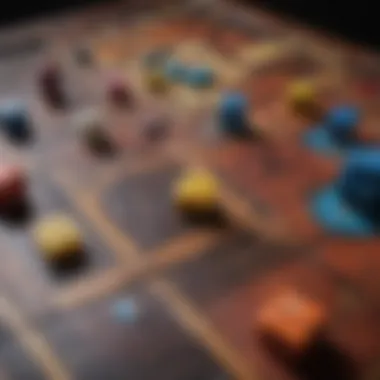Mathematical Patterns and Games: A Learning Connection


Intro
Mathematics, often seen as a cold and unforgiving discipline, has a surprisingly warm and engaging side when paired with games. Integrating gaming with mathematical principles creates a vibrant stage where numbers and patterns transform into enjoyable puzzles to solve. This symbiotic relationship not only elevates the learning experience but also sparks curiosity among students, educators, and lifelong learners alike.
Games provide a platform for students to explore patterns in a manner that feels natural rather than forced. As they try their hand at a mathematical game, they unknowingly delve into patterns that could easily go unnoticed in traditional learning environments. The rhythmic flow of gameplay promotes cognitive engagement, allowing learners to see the beauty of mathematics as a dynamic landscape of opportunities rather than a static collection of rules and formulas.
In this article, we step into the rich interplay between mathematical patterns and games, elucidating their relevance in educational contexts and individual learning. With each click of a dice or strategic move on a board, players embrace complex concepts that change how they understand mathematics. Through case studies and practical examples, we will illustrate how effectively designed games can illuminate mathematical theories and nurture critical thinking skills.
In delving deeper, we will highlight key research findings and the significance of these discoveries in contemporary education while offering insights into simplifying advanced ideas for better comprehension. By unraveling these concepts, readers will gain a profound appreciation of the elegance that lies at the intersection of games and mathematics.
So let’s embark on this intriguing journey, where mathematical patterns dance to the rhythm of engaging games.
Understanding Mathematical Patterns
Understanding mathematical patterns is pivotal as it lays the groundwork for grasping numerous concepts in both pure and applied mathematics. Within the framework of this article, patterns serve not just as a theoretical exploration but as practical tools that augment the way students engage with mathematics through games. Recognizing these patterns enhances analytical thinking and problem-solving capabilities. Additionally, this comprehension allows learners to make connections between disparate mathematical principles, facilitating a deeper appreciation for the subject.
Definition of Mathematical Patterns
Mathematical patterns are sequences or arrangements that reveal consistent relationships and regularity in numbers or shapes. These can manifest in various forms such as numbers, geometric shapes, or algebraic structures. For example, a simple numerical pattern can be as straightforward as the series 2, 4, 6, 8, which follows an additive rule of increasing by two. Understanding definitions and forms of these patterns forms a cornerstone of mathematical inquiry.
Types of Mathematical Patterns
Numerical Patterns
Numerical patterns are sequences of numbers that follow specific rules or formulas. The beauty of numerical patterns lies in their ability to simplify complex problems, allowing learners to approach seemingly daunting calculations with ease. A prime example would be Fibonacci numbers, where each number is the sum of the two preceding ones. This concept not only showcases addition but also illustrates how recursion operates in mathematics. Its appeal is largely due to its wide-ranging application, from financial forecasting to computer algorithms. However, sometimes students struggle to grasp these patterns due to the abstract nature of numbers.
Geometric Patterns
Geometric patterns include shapes and spatial relationships that repeat or follow specific structures. They can be found in tessellations or fractals, which exemplify how math operates in visual contexts. One compelling characteristic is the connection between geometric patterns and real-world applications, such as architecture or nature. For instance, the shapes of snowflakes exhibit remarkable patterns that extend natural beauty into the domain of mathematics. While geometric patterns hold a certain charm, they may require a foundational understanding of basic geometric principles to fully appreciate.
Algebraic Patterns
Algebraic patterns revolve around variables and the relationships between them. These patterns help in recognizing how changing one element affects another and often use expressions and equations. A commonly referenced example would be the way that linear equations form a straight line when graphed. Algebraic patterns are crucial as they prepare students for advanced concepts in calculus and beyond. However, the complexity of variables can sometimes pose a hurdle for learners, making a solid base in arithmetic essential.
Patterns in Nature and Art
Patterns are not confined to mathematical realms; they also permeate various aspects of nature and art. This interconnectedness emphasizes the universality of patterns, demonstrating how mathematics plays a significant role in understanding the world around us. From the symmetrical arrangement of petals in flowers to the spirals in seashells, nature showcases a plethora of mathematical principles that can be explored through games and interactive activities. Likewise, artists often employ mathematical concepts in their works, creating pieces that resonate with mathematical harmony. Recognizing these intersections can substantially enrich the educational experience, offering engaging ways to visualize and connect mathematical patterns with the real world.
The Historical Context of Mathematical Patterns
Understanding the historical context of mathematical patterns provides invaluable insights into how these concepts have evolved and influenced learning and teaching methods. The intricacies of patterns in mathematics aren't merely academic; they shape cognitive development and problem-solving approaches. By tapping into historical examples, educators can merge past knowledge with contemporary learning, making mathematics more relatable and engaging.
Ancient Civilizations and Patterns
Patterns in Egyptian Mathematics
Egyptian mathematics, often viewed through the lens of practicality, showcased patterns that were fundamental in the construction of monuments and in their agricultural practices. For instance, they developed a system for multiplication and division that utilized doubling principles, which can be seen as an early form of pattern recognition. The distinctive use of base 10 and fractions, particularly with unit fractions, is a key characteristic of their numerical system.
This approach to math wasn’t just an abstract exercise; it had real-world applications that made it a beneficial subject in this discussion. By bridging the gap between theory and practice, Egyptian mathematics allowed early practitioners to effectively manage resources, build monumental architecture, and calculate agricultural yields. However, while their methods were efficient, they lacked the formal notation we utilize today, which can pose challenges in comprehension for modern learners.
The unique feature of this ancient approach was its visual reliance. Hieroglyphics represented math concepts, turning the abstract into the tangible. This visual context can be advantageous for learners who benefit from graphic representations of mathematical principles. However, the downside is that it may alienate those more accustomed to contemporary numeric systems.
Patterns in Greek Geometry
Greek geometry, on the other hand, paved the way for systematic exploration of mathematical patterns through rigorous proofs and logical reasoning. Figures like Euclid and Pythagoras are synonymous with geometry, highlighting their meticulous methods of deriving formulas and theorems. Their work established foundational geometrical patterns, notably in the field of triangles and circles, which continue to be critical in education today.
The analytical nature of Greek geometry is a major asset for this article. It instills discipline in thought processes and provides a framework for students and educators to dissect mathematical problems logically. A unique feature of Greek mathematics was its philosophical underpinning, believing that understanding mathematical truths was a pathway to understanding the universe.
However, this rigorous approach can be daunting for some learners. The heavy emphasis on proofs might make geometry seem overly complex, discouraging those who prefer more straightforward applications of mathematical concepts. Striking a balance between the depth of Greek geometry and its practical application remains a challenge but is essential for effective teaching.
The Development of Pattern Recognition
The evolution of pattern recognition didn’t happen overnight. It required centuries of experimentation, observation, and analysis, leading to a more profound understanding of mathematical concepts. The journey from ancient practical mathematics to today's abstract theories reflects the changing perceptions of knowledge and learning.


Cognitive psychology plays a significant role in the development of mathematical pattern recognition. Studies have shown that recognizing patterns can improve a student’s ability to solve complex problems. Tools such as spatial reasoning and analogical transfer, which involve comparing new problems to previously solved ones, enhance learning. This skill set not only enriches the educational experience but also fosters creativity and innovation in problem-solving.
Unearthing these historical underpinnings is not merely an academic endeavor. It enriches our current understanding of math, leaving educators with profound insights into how to approach teaching in a way that acknowledges and utilizes these developments.
"Mathematics is the music of reason." – James Joseph Sylvester
In summary, the historical context of mathematical patterns lends depth to our discourse, highlighting the evolution of ideas that shape the way we engage with mathematics today. Whether through the practicality of Egyptian mathematics or the rigor of Greek geometry, the historical developments remind educators and students alike of the beauty and logic underlying mathematical patterns.
The Role of Games in Learning Mathematics
Games and mathematics might seem like an odd couple at first glance. However, when you dig deeper, you’ll find they complement each other quite beautifully. This section addresses why games are invaluable tools for learning mathematics, emphasizing various benefits and considering the right approaches to incorporate them effectively.
Games tap into the inquisitive minds of learners. They provide a context where mathematical patterns emerge naturally. Through engaging activities, learners not only practice their math skills but also discover the underlying principles that govern them. When students approach math in a playful manner, it can lead to richer understanding and retention of concepts.
Educational Games Overview
Educational games come in various forms, from traditional board games to modern digital applications. The aim remains steadfast: to impart mathematical skills while ensuring that students have a positive experience. Take, for example, games like Math Bingo or Math Jeopardy. These games encourage players to engage with numbers, formulas, and problem-solving tactics while fostering collaboration among peers. On the digital front, platforms like Prodigy Math or Khan Academy offer interactive lessons that adapt to each learner’s pace, blending education seamlessly with entertainment.
As a rule of thumb, successful educational games include:
- Clarity in objectives
- Engaging challenges
- Immediate feedback
- Opportunities for collaborative learning
Benefits of Game-Based Learning
Engagement and Motivation
Engagement is at the heart of game-based learning. When learners are engaged, they're likely to absorb and utilize knowledge more effectively. The thrill of competition, paired with the joy of achievement, makes learning math feel less like a chore and more like an adventure.
A key characteristic of this engagement lies in the immediate rewards provided by games. Students often receive instant feedback, allowing them to realize their progress in real-time. From gaining points to leveling up, every victory—no matter how small—fuels motivation.
However, one must also consider that the use of games shouldn’t overshadow the primary educational goals. While excitement is essential, the content must be impactful, ensuring that learners walk away with solid skills. The balance is tricky but achievable.
"The best way to predict your future is to create it."
–Peter Drucker
Improved Problem-Solving Skills
Another hallmark of game-based learning is its ability to sharpen problem-solving skills. Many games present puzzles that require critical thinking and analytical approaches, giving learners the chance to experiment with various solutions.
The distinctive feature of this skill enhancement is the iterative process; students try, fail, reassess, and try again. Through this cycle, they learn to navigate challenges without the fear of failure looming over them, an approach that most traditional educational settings often lack.
Furthermore, the diverse scenarios presented by games encourage adaptability. Learners must think on their feet, applying different mathematical principles to varying contexts. Such exposure to multifaceted problems fosters a deeper understanding of mathematical patterns, revealing how they can be applied in real-life situations.
To sum up, integrating games into mathematics education is not just about replacing textbooks with fun activities. It is strategically leveraging inherent motivation and engagement of games to elevate mathematical understanding, making patterns in mathematics come to life.
Types of Math Games and Patterns
Mathematics can often seem like a daunting subject to many students. However, the use of games provides an alternative approach that transforms learning into an enjoyable experience. The types of math games used can create a significant impact on how students grasp mathematical concepts, especially patterns. Engaging with games not only supports the curriculum but also nurtures critical thinking and enhances cognitive abilities.
In this section, we will explore two major categories of math games: puzzle games and strategy games. Each of these game types offers unique methods to delve into mathematical patterns, allowing students to engage actively rather than passively absorbing information.
Puzzle Games
Sudoku and Number Patterns
Sudoku is a popular number-placement puzzle that has gained popularity all over the world. It provides a unique opportunity to engage deeply with numerical patterns. The game's objective is straightforward: fill a 9x9 grid such that each row, column, and 3x3 region contains all digits from 1 to 9 without repetition. This not only tests the solver's logic skills but also encourages pattern recognition.
One of the key characteristics of Sudoku is its structured format. Every puzzle offers a different layout, ensuring that learners encounter various patterns while they play. Sudokus can vary in difficulty, making them accessible to a wide age range—from young learners to adults.
The main advantage of incorporating Sudoku into math curricula lies in its ability to foster problem-solving capabilities. Research shows that students who regularly play Sudoku can enhance their logical thinking skills and improve their overall mathematical reasoning. On the flip side, some learners might find Sudoku frustrating if they don’t receive sufficient guidance, particularly if they struggle with numerical patterns.
Crossword Puzzles with Mathematical Terms
Crossword puzzles are another engaging way to explore mathematical terminology and concepts. Unlike Sudoku, crossword puzzles depend more on vocabulary rather than numerical skills, making them a complementary tool to more traditional math games. Each clue is tied to a mathematician's term or principle, and students fill in the squares based on their understanding and knowledge.
A notable characteristic of crossword puzzles focusing on mathematical terms is their interactivity. This method promotes collaborative learning as students can work together to decipher clues, fostering a community around mathematics.


The uniqueness of these puzzles lies in their ability to cross-introduce various mathematical ideas through fun wordplay, enhancing vocabulary alongside critical thinking. However, students who aren’t familiar with specific terms might struggle, highlighting the need for prior knowledge to maximize the benefits.
Strategy Games
Board Games Incorporating Mathematics
Board games serve as an effective medium to teach mathematical concepts. Games like Monopoly or The Game of Life incorporate monetary systems and probability, allowing players to grasp mathematical principles in a relaxed environment. The appeal of board games often stems from their social nature, drawing in participants to focus their skills together towards a common aim.
One standout feature of these board games is their interactive scenario planning. Players must make decisions based on mathematical reasoning, such as budgeting funds or calculating risks. This aspect effectively reinforces students' understanding of patterns in a tangible context. Although entertaining, some board games may oversimplify mathematical concepts or risk relying too heavily on chance, leading to uneven learning outcomes.
Card Games Focusing on Patterns
Card games can likewise be a powerful tool for teaching math, especially those that require players to recognize and utilize patterns. Games like Set challenge players to identify sets of cards based on color, shape, and quantity, sharpening their attention to detail among various attributes.
The key characteristic of card games emphasizing patterns is their dynamic gameplay. Unlike more static board games, card games often shift moments rapidly, requiring players to think on their feet, a skill that translates well into real-world mathematics. The adaptability of card games makes them suitable for all ages and skill levels. However, it may also lead to fast-paced competition, which can be intimidating for students who may need more time to process patterns.
In summary, the diverse range of math games presents multiple ways to explore mathematical patterns. By integrating both puzzle and strategy games into learning, educators can offer students interest and relevance, thus encouraging lifelong engagement with mathematics. These games bridge the gap between abstract concepts and practical understanding, enhancing both cognitive skill and enjoyment of the subject.
Case Studies: Effective Use of Games in Mathematics
The integration of games into mathematics education is more than just a passing trend; it represents a transformative strategy for teaching and learning. This section shines a spotlight on various case studies that demonstrate how games can effectively enhance mathematical understanding. By exploring specific classroom implementations and community-based learning initiatives, we can uncover tangible benefits and revealing challenges faced by educators and learners alike.
Classroom Implementation
Success Stories from Educators
In the realm of education, success stories serve as powerful testimonies to the efficacy of incorporating games into mathematics curriculum. One significant aspect of these success stories is how they provide real-world evidence that engaging methodologies can prompt students to explore complex mathematical concepts joyfully. A prime example is a fifth-grade teacher who introduced a board game designed around fractions. The students developed a strong grasp of fraction manipulation while enjoying the competitive spirit of the game. This characteristic of success stories—showing real impact—is crucial as it offers a relatable narrative for other educators.
The unique feature of these stories often lies in how they showcase creativity in turning mundane, traditional lessons into lively educational experiences. One significant advantage of this approach is that it not only fosters a deep understanding of the subject matter but also enhances students' willingness to participate. A downside, however, can be the allocation of time. Preparing these games requires effort from educators, who may already feel stretched thin with curriculum requirements.
Student Learning Outcomes
Analyzing student learning outcomes within game-based settings gives a clear picture of how this strategy influences academic performance. The shift from passive absorption of knowledge to active participation marks a critical transformation. For instance, a case study in a high school found that students participating in math games showed a marked improvement in standardized test scores compared to their peers in traditional learning environments. This key characteristic highlights not only increased performance but also improved retention of mathematical concepts.
What makes this aspect particularly captivating is the way it aligns with emotional engagement. Students express excitement and pride when achieving success in these games, igniting a positive feedback loop that reinforces learning. Of course, one must consider the variability in student responses; while many thrive, some learners who struggle with certain concepts may find gameplay overwhelming. Nonetheless, the potential benefits, such as enhanced confidence and camaraderie among students, make this approach appealing.
Community-Based Learning
After-School Programs
After-school programs focusing on mathematics have gained traction due to their ability to offer learning beyond the usual classroom walls. Specifically, these programs often utilize games to spark interest and make learning fun. The noteworthy element here is the freedom these programs can afford educators to experiment without the constraints of standard curriculum requirements. For example, a local initiative introduced a math-themed escape room where kids could solve puzzles to 'escape' within a set time. This adventure not only solidified their mathematical skills but also fostered teamwork.
The unique feature of community-based after-school programs is that they provide an informal environment where students can interact with peers. This setting often mitigates the pressure students may feel during formal assessments. Yet, one must acknowledge that accessibility can be a barrier; not all students might be able to attend such programs due to transportation or scheduling conflicts.
Local Workshops and Events
Workshops and events designed to engage the community with mathematical gaming also play a vital role in the educational landscape. Through these events, participants receive hands-on experiences with various math games, reinforcing skills in a collaborative setting. A local workshop where families participated in math trivia games demonstrated this function vividly. They not only engaged in learning but also built community ties through shared experiences.
Furthermore, these events can accommodate diverse audiences, making mathematics accessible to risk-takers who might ordinarily shy away from the subject. The community-focused approach can bolster interest in mathematics across different age groups, ensuring that everyone leaves with a greater appreciation for mathematical patterns. Nevertheless, there can be challenges regarding logistical issues—such as crowd management and limited resources—where effective planning becomes essential.
By delving into these case studies, it becomes evident that the utilization of games in mathematics is a multifaceted strategy that can lead to impressive outcomes. While there are challenges to navigate, the potential benefits for student engagement and comprehension are clear.
Challenges in Integrating Games into Mathematics Education
The integration of games into mathematics education opens a treasure trove of opportunities but doesn't come without its own set of difficulties. Understanding these challenges is vital for educators, curriculum designers, and stakeholders who seek to leverage gaming as a tool to enhance mathematical learning. Game-based learning is not just a passing trend; it represents a substantial pedagogical shift. However, obstacles like curriculum constraints and teacher preparedness can impede its successful adoption. Recognizing and addressing these issues can ultimately shape more effective, engaging educational environments.
Curriculum Constraints
When it comes to embedding games into a math curriculum, constraints often emerge that can feel quite oppressive. While innovative educators may see the potential of games to draw students in, rigid curricula can stifle these efforts. Standardized tests place heavy emphasis on a certain type of learning, often prioritizing rote memorization over engaging problem-solving experiences. This leads to a situation where teachers feel pressured to focus on test reform and ensure that every concept is covered within the academic calendar.
Here are key considerations regarding curriculum constraints:
- Standardized Testing Pressure: Many educational institutions emphasize outcomes that can be measured through traditional assessments. This often results in skepticism about game-based learning.
- Lack of Flexibility: Curricula can be densely packed. Teachers might simply not have time to integrate games without compromising other important content.
- Alignment with Standards: Games must align with educational standards which may not always be clear in design or application.


Despite these hurdles, some educators have found success by creatively aligning games with curriculum goals, creating synergy instead of conflict. For instance, incorporating Sudoku puzzles can reinforce number sequencing while still hitting specific learning targets.
Teacher Training and Resources
Equipping teachers with the necessary skills and resources to integrate games into their classrooms is another major challenge. Many educators may lack access to professional development opportunities centered around game-based learning. As a result, they might feel uncertain about how to utilize games effectively, which undermines the potential benefits.
Several aspects influence the training and resources issue:
- Professional Development Gaps: Many conventional training programs overlook modern approaches, such as integrating digital games into lessons, leaving educators feeling stranded.
- Resource Availability: Schools with limited budgets may struggle to acquire the latest educational games, restricting teachers to outdated tools.
- Support Networks: Collaboration among teachers can be crucial; however, not all institutions foster a culture that promotes sharing effective practices and resources related to gaming.
Addressing these issues necessitates a concerted effort such as establishing partnerships with educational technology firms, advocating for comprehensive training programs, and encouraging peer-to-peer support networks. When teachers are equipped with both the knowledge and the materials they need, they can innovate with confidence.
Integrating games into mathematics education is not just about having fun but about transforming learning experiences to foster deeper understanding of mathematical concepts.
The journey toward integrating games into mathematics education is indeed fraught with challenges, but by confronting curriculum constraints and enhancing teacher training, the potential for enriching student learning remains profoundly promising.
Future Directions in Mathematical Gaming
Mathematical gaming stands at a crossroads, teetering between traditional methods and the vast digital landscape. Embracing this future, educators and developers are recognizing the shift in learning paradigms, integrating advanced technologies that not only engage students but also deepen their understanding of mathematical concepts. Considering that gaming can pull learners into the complexities of mathematics in a much more approachable manner, the expansion of tools and methods will only widen the reach of mathematical literacy.
Technological Advances
Online Platforms and Accessibility
Online platforms have revolutionized the landscape of educational games, allowing learners to access a rich array of resources from around the world. One significant advantage of these platforms is their ability to provide immediate feedback. This instant interaction helps not only in grasping mathematical concepts but also in reinforcing them. Furthermore, accessibility is a key characteristic—students from varying backgrounds can engage without the constraints imposed by physical resources.
Many of these platforms also host forums or community spaces. These spaces foster collaboration among learners, encouraging discussions and shared problem-solving. This social aspect can enhance motivation among students, making them less reluctant to tackle challenging areas of math.
However, a potential downside is the digital divide, where disparities in access to technology can exclude students who may benefit most. Schools and communities must find ways to bridge this gap, ensuring everyone has a seat at the table.
Virtual and Augmented Reality in Math Games
Virtual and augmented reality (VR and AR) offer thrilling ways to immerse students into mathematical environments. Instead of merely solving equations on paper, learners can visualize geometric constructions or manipulate algebraic expressions in three-dimensional spaces. A distinct feature of AR and VR is their ability to create simulations that connect theoretical math with real-world applications. This immersive quality not only captures the attention of students but also facilitates deeper learning experiences.
For example, imagine a student constructing a geometric figure in real time, moving their hands to adjust angles and sides, experiencing the underlying mathematics firsthand. This kind of interactive engagement makes abstract concepts tangible. However, developing VR and AR applications can be resource-intensive and may not always be feasible for every institution, leading to further discrepancies in learning opportunities.
Expanding Game Design
Collaborative Game Development
Getting students involved in collaborative game design blends creativity with mathematics. This approach invites learners to use mathematical concepts actively as they work together to create new games. The emphasis on teamwork is a standout characteristic—collaboration cultivates communication skills, as students share ideas and problem-solving strategies.
A unique aspect of this process is that it integrates not only mathematics but also critical thinking and creativity. Students are tasked with designing rules and objectives that reflect mathematical principles, ensuring they actively apply their knowledge rather than passively receive it.
One challenge is that not every student may feel comfortable in a group setting or may struggle with collaboration, which can hinder the experience. Thus, educators need to craft diverse group dynamics to ensure everyone’s voice is heard and valued.
Customizable Games for Personalized Learning
Customizable games address the varied learning paces and styles among students. This adaptability allows learners to focus on areas where they need improvement, or push themselves in topics they find intriguing. A vital strength here is personalization—these games can be fine-tuned to suit individual needs, making them an appealing choice for differentiated learning.
Large online platforms often feature this customizable aspect, letting students choose levels of difficulty or specific math topics to tackle. It’s like having a tailor-made suit for each student’s learning journey. Still, the downside can be the potential for frustration; if a game lacks clarity or is poorly designed, students may become disheartened, seeing it as another task rather than an engaging experience.
In an era where technology intertwines with education, understanding these future directions equips us to foster more engaging and effective learning experiences.
As we look to these innovations, it is crucial to navigate both the benefits and challenges they pose, ensuring that educational gaming remains a fruitful avenue for exploring mathematical patterns.
Culmination
As we draw the curtain on our exploration of engaging games and mathematical patterns, it's essential to understand just how pivotal this connection is in educational settings and beyond. The integration of games not only aids in grasping complex mathematical concepts but serves to ignite curiosity and foster a love for learning that might otherwise stay dormant.
Recap of Key Points
In revisiting key points discussed in this article:
- Diversity of Patterns: We delved into various types of mathematical patterns—numerical, geometric, and algebraic—and their omnipresence in our lives.
- Historical Context: We uncovered the historical depth, tracing back through where patterns emerged in ancient civilizations, influencing modern mathematics.
- Role of Games: The discussion emphasized how games enrich the learning experience by providing immersive pathways to understand mathematical principles.
- Real-Life Applications: Case studies illustrated successful strategies adopted across classrooms and community programs, enhancing student engagement and understanding of mathematics through practical application.
- Challenges and Solutions: We acknowledged the hurdles faced when incorporating games into the standard curriculum and explored potential solutions that could benefit educators and learners alike.
Final Thoughts on Games and Mathematical Patterns
To wrap things up, one must appreciate that games are much more than mere tools for distraction; they are dynamic vessels for learning and discovery. The interplay between mathematical patterns and gaming not only enhances cognitive ability but gives students the chance to explore math in a world that is familiar and engaging. Games like Sudoku, Monopoly, or even Minecraft illustrate patterns in a way that's digestible and fun.
Additionally, as technology continues to propel forward, once-novel concepts like virtual and augmented reality are set to redefine how we engage with mathematical ideas. Just picture students delving into 3D models of geometric shapes or navigating through puzzle-based terrains that require strategic thinking and pattern recognition to succeed. The road ahead seems promising, and it's the collaborative effort of educators, game developers, and learners who will ensure that the relationship between math and games remains vibrant and impactful.















